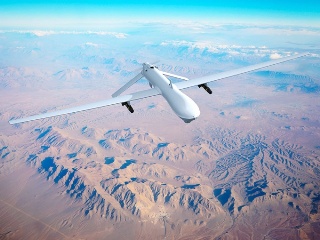Oct 25 2014
On the day when Niagara Falls’ 107th Airlift Wing stopped flying cargo planes and transitioned to a mission of controlling military drones, a Law School forum wrestled with the implications of using these unmanned instruments of war in the Middle East.
 The use of military drones has increased dramatically during the Obama administration, according to military intelligence expert Capt. Glenn Sulmasy.
The use of military drones has increased dramatically during the Obama administration, according to military intelligence expert Capt. Glenn Sulmasy.
Sponsored by the Buffalo Human Rights Center and the Federalist Society, the Sept. 25 forum - titled “U.S. Drone Policy in the Middle East: The Legal, Moral and Political Implications” — featured two experts who brought the insights of military intelligence and the human rights sphere to the discussion. Their separate presentations were followed by dialogue with the audience of about 45 people, moderated by Tara J. Melish, associate professor of law and director of the Buffalo Human Rights Center.
Reflecting the perspective of U.S. military policy and foreign affairs was Capt. Glenn Sulmasy, chair and professor at the U.S. Coast Guard Academy. He titled his remarks “Foreign Affairs in Chaos.”
“We have no doctrine,” Sulmasy said, ticking off a list of problematic situations: Libya, Egypt, the Gaza Strip, Iran’s continuing nuclear program, Russia’s adventurism in Ukraine and, of course, the suddenly high-profile threat of ISIS in Iraq and Syria.
Intervening militarily in Syria, as the United States did when it launched airstrikes against ISIS targets, raises the question of justification for that action under U.S. and international law, Sulmasy said. “We’re not at war with Syria,” he said. “What is the president relying on domestically to go into another country and violate their territorial integrity in order to rid us of something we know is bad? Executive power. There are times when a president has to act in self-defense and respond on behalf of the country. And so we have to ask, is ISIS in Syria a threat to the United States? That’s a tough question. Is it a law enforcement operation or is it a war?”
The use of military drones has increased dramatically during the Obama administration, Sulmasy said, with more than 400 drone attacks and 2,500 people killed. “President Obama has killed six times the number of people that President Bush did using drones,” he said. “I think he thinks of it more as counterterrorism, not warfare.”
But such widespread use of drones, he said, raises a couple of concerns. One is that without ground troops, no prisoners are captured — and thus no valuable intelligence about enemy operations is gathered. “Not having that has hurt us,” he said.
Sulmasy also criticized the government’s opacity around the use of drones. “We don’t have an idea of what’s going on,” he said. “Drones are a tool of war, but there still needs to be some level of transparency. This counterterrorism idea makes it secret immediately.”
The second presenter was Christopher Rogers, a program officer for the Regional Policy Initiative on Afghanistan & Pakistan of the Open Society Foundations.
Rogers discussed the results of several years of research that Open Society has done in Pakistan around the effects of drone strikes. “We investigated 27 different strikes, interviewing over 100 witnesses and victims, and documenting credible claims of civilian casualties,” he said. The survey confirmed that civilians do fall victim to strikes intended to kill enemy combatants, and showed that victims of drone strikes are not informed about why they were targeted. “That relates more broadly to a question of fundamental dignity and what’s owed to people in these places,” Rogers said.
He also said it’s important to consider the context of the societies in which drone strikes happen. “These are people who are illiterate, impoverished and who have very little access to even their own domestic economy and no access to courts,” he said, noting that, for example, in tribal areas of Pakistan, a rudimentary law code implemented by British colonizers in the 19th century still holds sway.
“We’re trying to measure success in body counts and kills, and not development of the rule of law in these places,” Rogers said.
He also asserted the United States has stretched the limits of some principles of international law, such as the idea that force is justified only to defend against an imminent attack — a move made easier by advances in drone technology. “The technology enables the United States to use force in a way that wasn’t possible, either politically or practically or technologically, before. That does pose real challenges to international law,” he said.
And stretching those principles, Rogers said, increases the risk that other nations will do likewise. “Other countries can justify the use of force using the same arguments,” he said. “When the United States weakens these principles, other states will use them and it weakens the international order.”